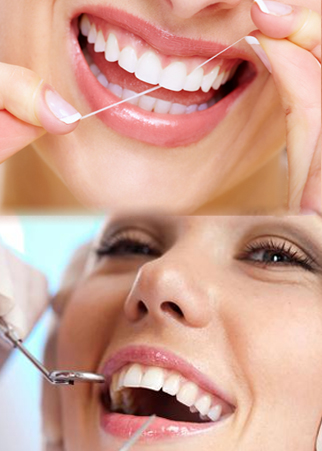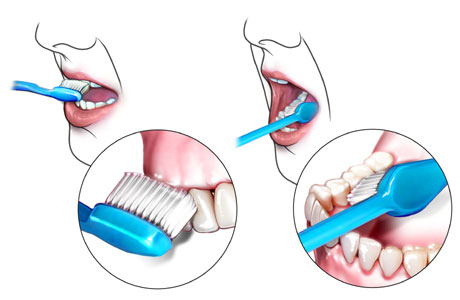

Bleeding gums is among the common conditions affecting the oral cavity. The Chinese might have noticed bleeding gums as early as 2500 BC. They termed the associated diseases as "Ya-Kon" which means diseases of soft tissue surrounding the teeth. This problem still continues to affect us even with so many modern facilities available in the field of oral care. Gum disease begins with plaque, a sticky film of food particles, germs and saliva. If not removed, plaque will settle at the gum line. The germs will produce toxins that makes the gums red, tender and likely to bleed when brushing your teeth. There are chronic conditions and even some medications that can cause plaque to accumulate more quickly. The purpose of daily brushing rinsing and flossing is to clean away this plaque. When this plaque is not removed it can harden into tartar which builds up along the gum line and traps germs below. The mildest form of gum disease is called gingivitis and is the most common.
The primary cause of gingivitis is the bacteria that coat your teeth, and if oral hygiene is poor, it forms a sticky white substance called plaque. The bacteria here proliferates faster and produces toxins that irritates your gums, keeping them swollen and red. When they are left untreated, they will destroy the tissues connecting the gums to the tooth, and eventually the tooth to the bones, causing a deep pocket and eventually attacks the bony structure. It has now progressed into what we call periodontitis, which is an irreversible form of gum disease.
The following medical conditions are some of the possible causes of Bleeding gums as a symptom.
There are a number of effective brushing techniques. Since tooth position and gum condition vary, patients are advised to check with their dentist to determine which is the best one for them.
In case of any doubt consult your dentist as to the correct way of brushing.

Incorrect brushing, such as using a back and forth motion, can cause the gum surface to recede. It can also expose the root surface and cause it to wear away. You also risk receding the gum line.
Watch Video
Brushing and flossing should be done at least twice daily - morning and night. The following regime is convenient and can be used as a guide line -
It is very important for a baby to learn good dental habits early. But remember it is just as important to make brushing teeth fun as it is to get them 100% clean.
As soon as the baby permits, start cleaning his/her mouth with a piece of gauze wrapped on your finger. This gets the child used to the idea of oral hygiene at a very early age.
For babies and toddlers a special baby toothbrush is recommended. It should have very soft and rounded bristles that will not irritate baby's soft gums, a small oval head to easily reach all areas of baby's mouth and a long handle so you can help with brushing.
From around 3 years of age it's time to start using a children's or junior toothbrush. A good children's toothbrush will have a small oval head, soft and rounded bristles and a long handle. You should still help with tooth brushing because it's not until a child is about 10 years that he has sufficient fine motor control to brush alone.
Teeth should be brushed twice a day for at least two minutes each time. You should also introduce your child to dental floss early so they become proficient at cleaning the areas in between teeth where plaque builds up.
In general, a toothbrush head should be small (1" by 1/2") for easy access. It should have a long, wide handle for a firm grasp. It should have soft, nylon bristles with round ends. Some brushes are too abrasive and can wear down teeth. A soft, rounded, multi-tufted brush can clean teeth effectively. Press just firmly enough to reach the spaces between the teeth as well as the surface. Medium and hard bristles are not recommended
You should change your tooth brush at least once every 2-3 months.
Using an electric rotary toothbrush is far more efficient and effective in overall plaque removal and massaging of the gums. The one we recommend is the Braun Oral B Ultra.
 Bleeding gums is among the common conditions affecting the oral cavity. The Chinese might have noticed bleeding gums as early as 2500 BC. They termed the associated diseases as "Ya-Kon" which means diseases of soft tissue surrounding the teeth. This problem still continues to affect us even with so many modern facilities available in the field of oral care. Gum disease begins with plaque, a sticky film of food particles, germs and saliva. If not removed, plaque will settle at the gum line. The germs will produce toxins that makes the gums red, tender and likely to bleed when brushing your teeth. There are chronic conditions and even some medications that can cause plaque to accumulate more quickly. The purpose of daily brushing rinsing and flossing is to clean away this plaque. When this plaque is not removed it can harden into tartar which builds up along the gum line and traps germs below. The mildest form of gum disease is called gingivitis and is the most common.
Bleeding gums is among the common conditions affecting the oral cavity. The Chinese might have noticed bleeding gums as early as 2500 BC. They termed the associated diseases as "Ya-Kon" which means diseases of soft tissue surrounding the teeth. This problem still continues to affect us even with so many modern facilities available in the field of oral care. Gum disease begins with plaque, a sticky film of food particles, germs and saliva. If not removed, plaque will settle at the gum line. The germs will produce toxins that makes the gums red, tender and likely to bleed when brushing your teeth. There are chronic conditions and even some medications that can cause plaque to accumulate more quickly. The purpose of daily brushing rinsing and flossing is to clean away this plaque. When this plaque is not removed it can harden into tartar which builds up along the gum line and traps germs below. The mildest form of gum disease is called gingivitis and is the most common.
 The primary cause of gingivitis is the bacteria that coat your teeth, and if oral hygiene is poor, it forms a sticky white substance called plaque. The bacteria here proliferates faster and produces toxins that irritates your gums, keeping them swollen and red. When they are left untreated, they will destroy the tissues connecting the gums to the tooth, and eventually the tooth to the bones, causing a deep pocket and eventually attacks the bony structure. It has now progressed into what we call periodontitis, which is an irreversible form of gum disease.
The primary cause of gingivitis is the bacteria that coat your teeth, and if oral hygiene is poor, it forms a sticky white substance called plaque. The bacteria here proliferates faster and produces toxins that irritates your gums, keeping them swollen and red. When they are left untreated, they will destroy the tissues connecting the gums to the tooth, and eventually the tooth to the bones, causing a deep pocket and eventually attacks the bony structure. It has now progressed into what we call periodontitis, which is an irreversible form of gum disease.
The following medical conditions are some of the possible causes of Bleeding gums as a symptom.